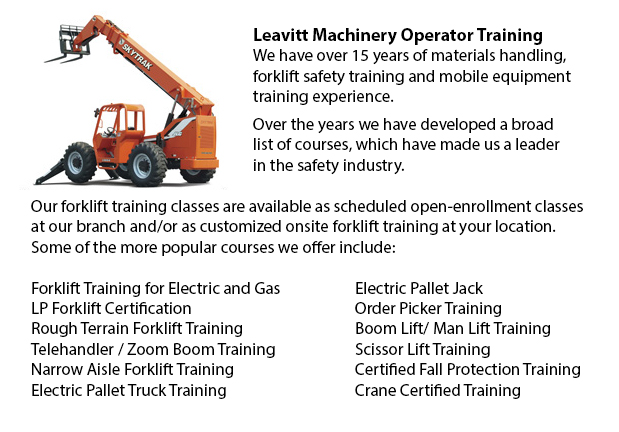
Telescopic Training Oakville - The telescopic handler forklift is more often known as a telehandler, and is an equipment that can lift products and materials to greater heights and has more versatility as opposed to a conventional forklift. It is often preferred over the traditional masted counterbalance truck (standard and rough terrain). Whether used for transporting raw materials into the back of a dump truck or for transporting pallets within a warehouse, the telescopic forklift is an important machine. Accredited telescopic handler training is essential to ensure the safe and efficient utilization of the unit.
A telescopic forklift is designed to lift heavy stuff using an arm, that extends in parts similar to a telescope. To select a telescopic forklift, you should take into account how the equipment will be utilized and for how long. Required lift heights and work site terrain should be taken into consideration. Parts, cost and warranty are all factors involved in buying a telescopic forklift. If you are leasing, you will want to compare prices, terms and delivery costs.
Telescopic forklifts come in various sizes. Size influences the amount of weight that can be loaded onto the lift, and the heights that could be safely attained. A small- to medium-sized telescopic forklift is perfect for transporting supplies into the rear of a pick-up truck. Lifting heavier things up higher will need a bigger lift. Careful consideration of how the lift would be used helps ensures you would choose the right size for stability and safety.
When choosing this type of machine, attachments even should be considered. Find out from the manufacturer what attachments are available. There are bucket attachments, pallet attachments as well as various attachments for specific purposes.
Work site terrain influences the variety of tires for the telehandler. Cushion tires are made of rubber all the way through, and are found on smaller units. Cushion tires are appropriate for telehandlers being used in a warehouse with a concrete floor. They give stability and durability. Pneumatic tires are usually on larger units made for use on varied, outdoor terrain where there could be rock, dirt, concrete and asphalt. They offer the best articulation and traction.
-
Order Picker License Oakville
Order Picker License Oakville - Order preparation operation or order picking as it is more normally known is a method used within warehouse operations and consists of employees called order pickers. The order picker's task is to collect and take arti... More -
Forklift Operator Certification Oakville
Forklift Operator Certification Oakville - Forklift operator certification is normally needed for personnel working within industrial, warehouse or construction setting to guarantee the safe utilization of forklifts. Workplace training need to follow... More -
Scissor Lift Certification Oakville
Scissor Lift Certification Oakville - A lot of worksites and tradespeople like iron workers, welders and masons utilize scissor lift platforms to help them reach elevated work areas. The utilization of a scissor lift is usually secondary to their tra... More -
Forklift Training Courses Oakville
Forklift Training Courses Oakville - When forklift operator safety training is customized for illiteracy, training time is reduced by 50%. Train the trainer, forklift training certification and lift-truck operator driver safety training evaluation pr... More -
Manlift Training Oakville
Manlift Training Oakville - There are numerous manlift training programs which offer a review of the manlift machinery. The practicum portion of the training is one more vital portion of the course. In this section the trainee has chance to demonstra... More -
Boom Lift License Oakville
Boom Lift License Oakville - To operate an aerial boom lift, operators should be licensed through training that can be obtained utilizing both classroom sessions and practical training and by attaining a boom lift license. Instruction should be given... More -
Crane / Overhead Crane / Self-Erect Crane / Truck Mounted Crane / Hydraulic Cranes Training in Oakville
Bridge cranes or likewise called overhead cranes are actually a type of industrial material handling crane using a line and hook mechanism that runs on a horizontal beam running along two widely separated rails. Several overhead cranes could be seen... More -
Telehandler Training in Oakville
Telescopic handlers normally called telehandlers for short, are an extremely popular piece of heavy construction machinery. They are widely utilized in the construction and agricultural trades. These machines have maximum reaching ability and could g... More

Forklift Training Oakville
TOLL FREE: 1-888-254-6157
Oakville, Ontario
forklifttrainingoakville.com
Email Us
About Us


